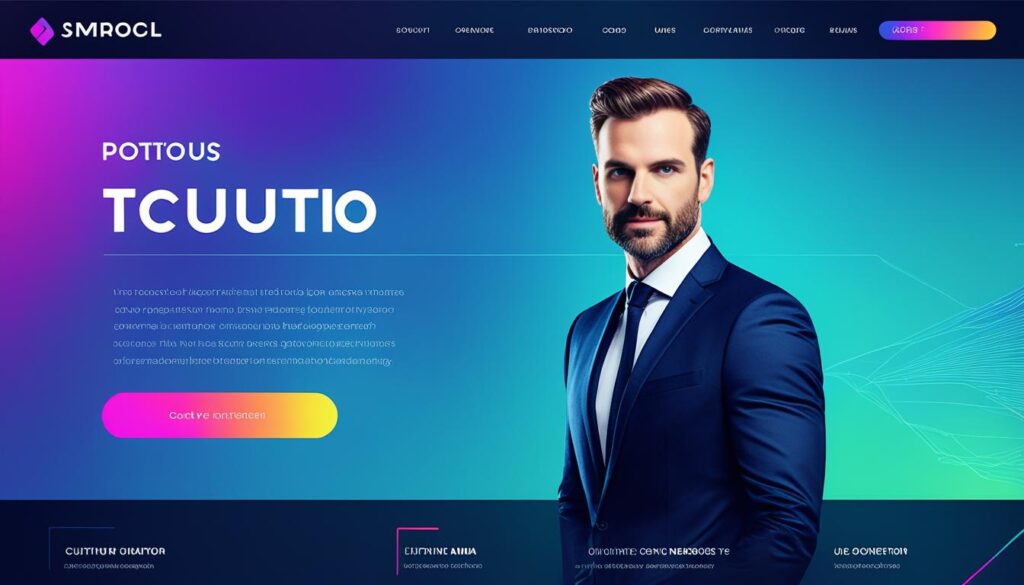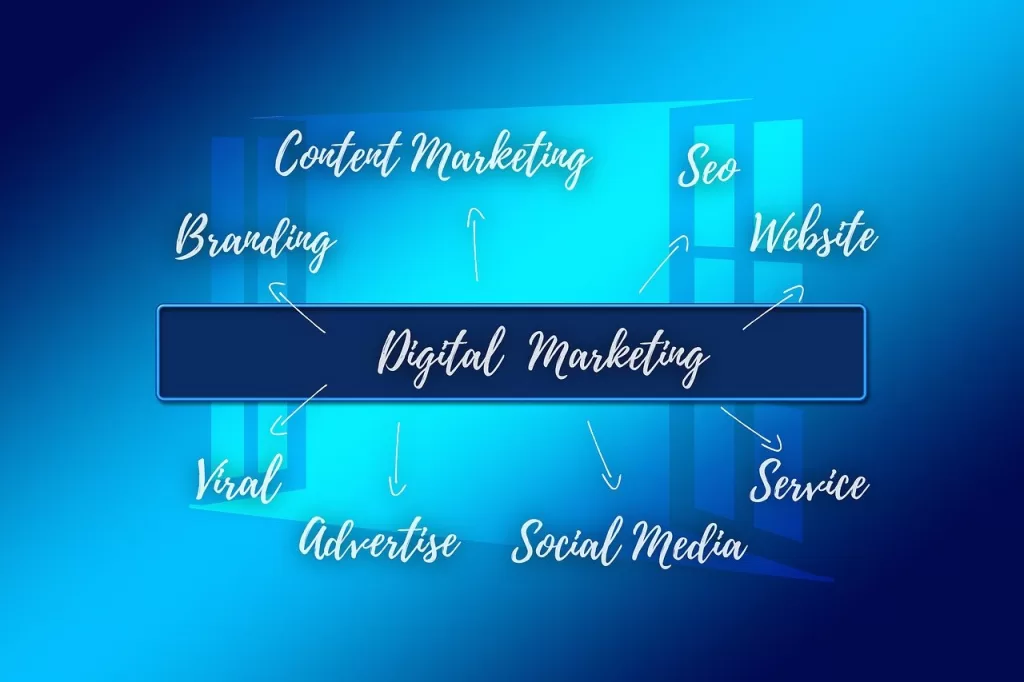Greetings! Are you looking to make your website stand out from the crowd? In the ever-evolving digital landscape, it’s crucial to constantly innovate and optimize your website to increase its online visibility and attract more organic traffic. To help you achieve this, we have gathered nine futuristic designs that will take your website to the next level in 3021.
Optimizing your website goes beyond just aesthetics. It’s about enhancing the user experience and implementing effective SEO strategies. By incorporating these designs and techniques, you can improve search rankings and create a unique online presence that will captivate your visitors.
To begin, let’s explore the world of virtual realities and the seamless integration that can revolutionize user experience. We’ll also delve into the power of intuitive AI interfaces and how they can personalize content and adapt to user behavior in real-time.
But that’s not all! We will also discuss eco-conscious design and how it can make your website environmentally friendly. Moreover, we’ll explore the balance between aesthetic appeal and practicality, showcasing the merging of art and functionality in website design. And of course, we can’t forget about futuristic SEO strategies that can boost your search rankings and attract more organic traffic.
So, are you ready to embark on a journey into the future of website design? Let’s dive in together and unlock the true potential of your online presence.
Key Takeaways:
- Implementing futuristic designs can help your website stand out and attract more organic traffic.
- Optimizing your website for search engines is crucial for improving search rankings.
- The integration of virtual realities and intuitive AI interfaces can enhance user experience and engagement.
- Eco-conscious design is a growing trend that contributes to the sustainability of the planet.
- The merging of art and functionality creates visually appealing and practical websites.
Embracing the Digital Evolution: Seamless Integration of Virtual Realities
In today’s rapidly evolving digital landscape, websites need to keep up with the changing trends to provide an immersive user experience. As the digital evolution progresses, virtual reality integration has emerged as a transformative technology that enhances user engagement and satisfaction. By seamlessly merging virtual realities with website design, businesses can create interactive interfaces that captivate their audience and set themselves apart from the competition.
The integration of virtual reality opens up endless possibilities for website design. It allows users to step into a virtual environment and interact with content in ways previously unimaginable. Whether it’s exploring a virtual showroom, experiencing a virtual tour, or participating in virtual events, the immersive user experience created by virtual reality integration is unparalleled.
Interactive interfaces play a crucial role in this digital transformation. By incorporating interactive elements such as 360-degree images, virtual reality videos, and interactive 3D models, websites can engage visitors on a whole new level. These interfaces provide a sense of agency and enable users to actively participate in their online journey, leading to increased satisfaction and longer browsing times.
Moreover, the seamless integration of virtual realities enhances the accessibility of content. Users no longer need specialized devices to experience virtual reality; with the advancements in web technology, virtual reality experiences can be accessed directly through web browsers. This eliminates barriers and allows a wider audience to enjoy the benefits of immersive digital experiences.
By embracing the digital evolution and leveraging the power of virtual reality integration, businesses can elevate their online presence and provide a truly memorable user experience. The possibilities are endless, and the potential for growth is tremendous. Interactive interfaces and immersive virtual realities are shaping the future of website design, and those who embrace these innovations will stand out in the digital landscape.
Revolutionizing User Experience with Intuitive AI Interfaces
In today’s digital landscape, user experience plays a pivotal role in the success of a website. To deliver an exceptional user experience, businesses are turning to intuitive AI interfaces. These interfaces leverage the power of artificial intelligence and machine learning to create personalized, interactive, and dynamic user experiences.
Personalized Content with Machine Learning
One of the key benefits of AI interfaces is the ability to deliver personalized content to website visitors. Machine learning algorithms analyze vast amounts of user data, such as browsing behavior, preferences, and demographics, to create tailored content recommendations. This personalized approach enhances user engagement, increases conversion rates, and fosters brand loyalty.
Through AI-driven content personalization, businesses can present relevant product recommendations, offer customized promotions, and provide targeted content based on individual user interests. This level of personalization creates a more immersive and enjoyable user experience, increasing the likelihood of achieving desired actions and conversions.
Interactive AI Assistants
Another exciting aspect of AI interfaces is the integration of interactive AI assistants. These virtual assistants, powered by artificial intelligence and natural language processing, enable users to interact with websites through voice commands or text-based conversations. Interactive AI assistants can answer user queries, provide real-time support, and guide users through complex processes.
The presence of interactive AI assistants on websites adds a human-like touch, making the user experience more engaging and interactive. These assistants can offer personalized recommendations, suggest relevant information, and even provide a conversational element that simulates human interaction. By incorporating interactive AI assistants, businesses can enhance user satisfaction and streamline user journeys.
Real-time User Behaviour Adaptation
One of the most powerful capabilities of AI interfaces is real-time user behavior analysis. By continuously monitoring and analyzing user interactions, AI interfaces can adapt and respond to user behavior in real-time. This allows websites to dynamically adjust content, layouts, and functionalities to meet the unique needs and preferences of individual users.
Real-time user behavior adaptation enables websites to provide a tailored user experience that evolves with each user’s actions and interests. For example, if a user frequently interacts with certain types of content, the AI interface can prioritize and customize the presentation of similar content to better align with the user’s interests. This level of personalization enhances user satisfaction and drives higher engagement.
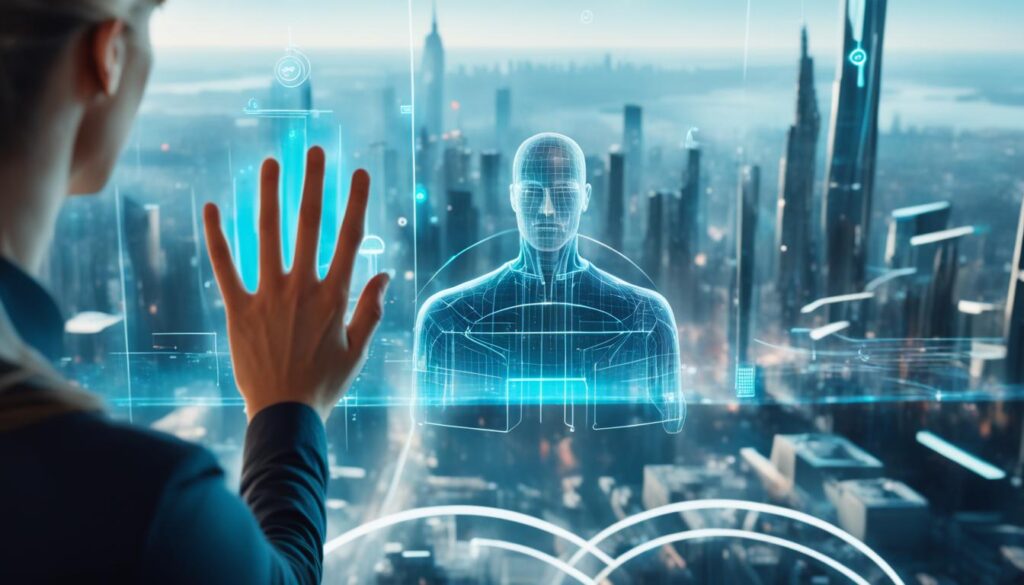
| Benefits of Intuitive AI Interfaces | Examples |
|---|---|
| Personalized user experiences | Customized product recommendations based on user preferences |
| Enhanced user engagement | Interactive AI assistants guiding users through complex processes |
| Improved conversion rates | Real-time user behavior adaptation to optimize content presentation |
| Streamlined user journeys | AI interfaces responding to user queries and providing real-time support |
Eco-conscious Design: Websites That Give Back to the Planet
In today’s world, sustainability and environmental impact have become increasingly important considerations in every aspect of our lives. This includes website design. As more businesses and individuals adopt eco-conscious practices, it is crucial for websites to follow suit and contribute to a greener future. In this section, we will explore the concept of eco-conscious design and how websites can make a positive environmental impact.
One of the key aspects of eco-conscious design is sustainability. This means designing websites that are environmentally friendly and promote responsible resource management. By optimizing energy usage, reducing carbon emissions, and adopting renewable energy sources, websites can significantly minimize their environmental impact.
“Eco-conscious design goes beyond reducing energy consumption. It also involves using sustainable materials and processes that minimize waste and pollution.”
Green websites are a prime example of eco-conscious design. These websites prioritize sustainability by incorporating elements such as renewable energy usage, energy-efficient servers, and eco-friendly hosting services. Green websites also minimize their carbon footprint by implementing efficient coding practices and optimizing content delivery.
To give you a visual representation of the impact of eco-conscious design, take a look at the image below:
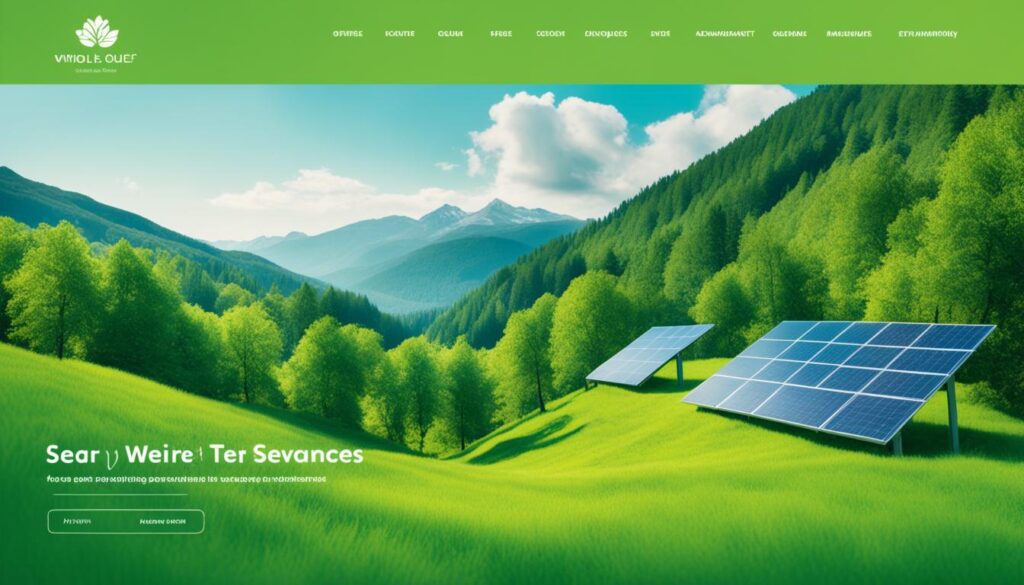
By embracing eco-conscious design, websites can contribute to the overall sustainability efforts and have a positive impact on the environment. In the next section, we will explore the merging of art and functionality in website design, creating aesthetically pleasing and user-friendly experiences.
Aesthetic and Practical: The Merging of Art and Functionality
In today’s digital landscape, website design goes beyond mere functionality. It is about creating an aesthetic experience that captivates users while ensuring practicality and seamless functionality. This section will delve into the merging of art and functionality in website design, showcasing how these elements can work harmoniously together to create visually stunning and user-friendly websites.
Innovative Use of White Space
One of the key design principles in achieving a visually appealing website is the innovative use of white space. Also known as negative space, white space refers to the empty spaces between elements on a webpage. This clever utilization of white space helps create a sense of balance and harmony in the overall design. By strategically placing elements and using ample white space, designers can draw attention to key elements on the page, improve readability, and enhance the overall user experience.
Harmonious Color Schemes Inspired by Nature
Color plays a crucial role in website design, evoking emotions and setting the tone for the user’s experience. Harmonious color schemes, inspired by nature, are becoming increasingly popular in web design. By selecting colors that complement each other and taking inspiration from nature’s palette, designers can create visually stunning websites that resonate with users. From soothing blues reminiscent of serene oceans to vibrant greens reminiscent of lush forests, the possibilities are endless. Incorporating harmonious color schemes not only adds aesthetic value but also enhances the overall user experience.
Typography as a Design Element
Typography is not just about choosing the right font. It is a design element that can significantly impact the look and feel of a website. By carefully selecting fonts and paying attention to typographic details such as line spacing, kerning, and font sizes, designers can create a visually pleasing and readable website. Typography sets the tone for the website’s personality, whether it’s formal, playful, elegant, or modern. By combining different fonts and using hierarchy effectively, designers can guide users’ attention and create a memorable user experience.
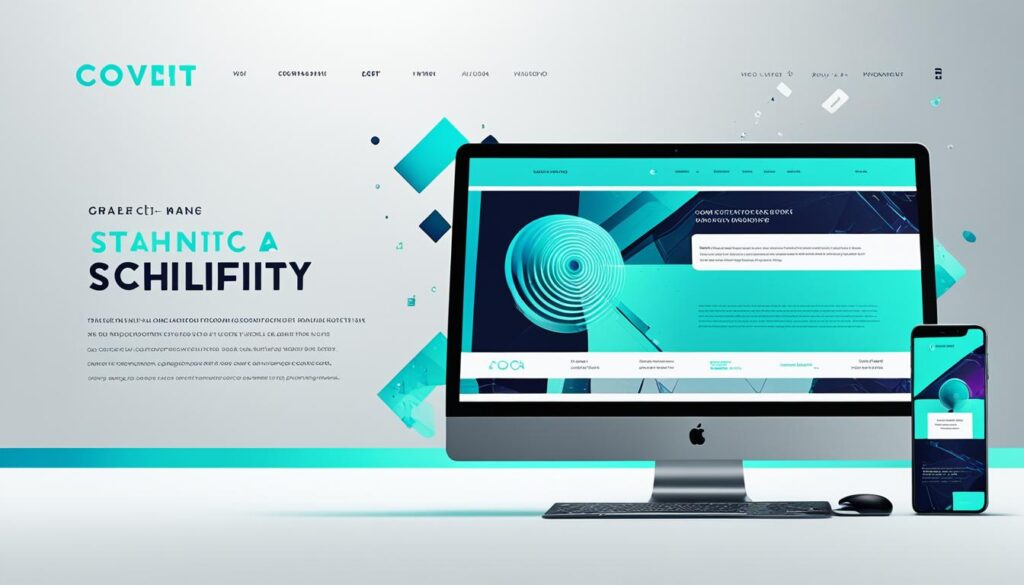
Improve Search Rankings with Futuristic SEO Strategies
In today’s competitive digital landscape, improving your website’s search rankings is crucial for attracting organic traffic and increasing online visibility. To stay ahead of the curve, it’s essential to embrace futuristic SEO strategies that can elevate your website’s performance. In this section, we will explore key tactics such as unique content creation and meta tags optimization that can help you improve your search rankings and drive more organic traffic to your website.

“Unique content creation is the cornerstone of a successful SEO strategy. By offering valuable and original content, search engines will view your website as a reliable and authoritative source.”
One of the most effective ways to improve your search rankings is through unique content creation. By producing high-quality and original content, you can attract and engage your target audience while establishing your website as a trusted authority in your industry. Search engines prioritize websites that offer valuable and relevant content, so investing time and effort into creating unique articles, blog posts, and landing pages can significantly boost your search rankings.
Optimizing your meta tags is another essential aspect of futuristic SEO strategies. Meta tags, including title tags and meta descriptions, provide search engines with valuable information about your web pages. By optimizing these tags with relevant keywords and compelling descriptions, you can enhance your website’s visibility in search engine results pages (SERPs) and entice users to click on your link.
Additionally, meta tags optimization plays a crucial role in improving your website’s user experience. Well-crafted meta tags provide concise and accurate information about your web pages, helping users understand the relevance and value of your content. By optimizing your meta tags, you can attract more qualified traffic to your site and increase the chances of converting visitors into customers or subscribers.
Furthermore, futuristic SEO strategies require a comprehensive approach that goes beyond content creation and meta tags optimization. It’s crucial to focus on other elements such as mobile optimization, site speed, and user-friendly navigation. By prioritizing these factors and staying updated on the latest SEO trends and algorithm updates, you can ensure your website remains highly visible and easily accessible to both search engines and users.
In conclusion, implementing futuristic SEO strategies is essential for improving your website’s search rankings and driving organic traffic. By focusing on unique content creation, meta tags optimization, and other crucial elements, you can stay ahead of the competition and provide a seamless user experience. Embrace the power of futuristic SEO strategies today and pave the way for long-term success in the digital landscape.
Hyper-Personalization: Crafting Unique Journeys for Each Visitor
In the fast-paced digital landscape, hyper-personalization has emerged as a game-changing strategy for website design. By tailoring the user experience to individual preferences and needs, website owners can create unique journeys for each visitor. This approach goes beyond traditional personalization techniques and focuses on delivering highly relevant and engaging content that resonates with users on a deeper level.
Dynamic Content Delivery Based on User Data
One of the key aspects of hyper-personalization is the dynamic delivery of content based on user data. By leveraging data from previous interactions, browsing behavior, and demographic information, websites can present customized content that aligns with the interests and preferences of each visitor. This level of personalization not only enhances user engagement but also increases the chances of conversion and customer retention.
To achieve dynamic content delivery, websites utilize sophisticated algorithms and machine learning models that analyze vast amounts of data in real time. These models can identify patterns, predict user preferences, and make data-driven decisions about the type of content that should be displayed to a particular visitor. By continuously adapting and refining content delivery based on user feedback and behavior, websites can create truly personalized experiences that foster meaningful connections with their audience.
Adaptive Storytelling Techniques
In the era of hyper-personalization, storytelling takes on a new dimension. Websites are now able to dynamically adapt their narrative based on contextual cues and user preferences. Adaptive storytelling techniques allow websites to present content in a way that resonates with each visitor, creating a more immersive and engaging experience.
Through the use of adaptive storytelling, websites can tailor the presentation of information, visuals, and interactive elements to match the unique preferences of each user. This not only captivates the audience but also increases their emotional connection to the brand or message being conveyed. By crafting narratives that speak directly to individuals, websites can forge deeper connections and build long-lasting relationships with their visitors.
Geolocation and Contextual Visitor Awareness
Another crucial element of hyper-personalization is the integration of geolocation and contextual visitor awareness. By leveraging geolocation data, websites can provide location-specific content and offers that are relevant to the user’s current whereabouts. This enables businesses to deliver targeted messages, promotions, and recommendations that cater to the local needs and interests of their audience.
Furthermore, contextual visitor awareness allows websites to understand the specific context in which users are accessing their site. This includes factors such as the device being used, the time of day, the user’s browsing history, and more. By considering these contextual cues, websites can further enhance the personalization of the user experience by adapting the design, layout, and content presentation accordingly.
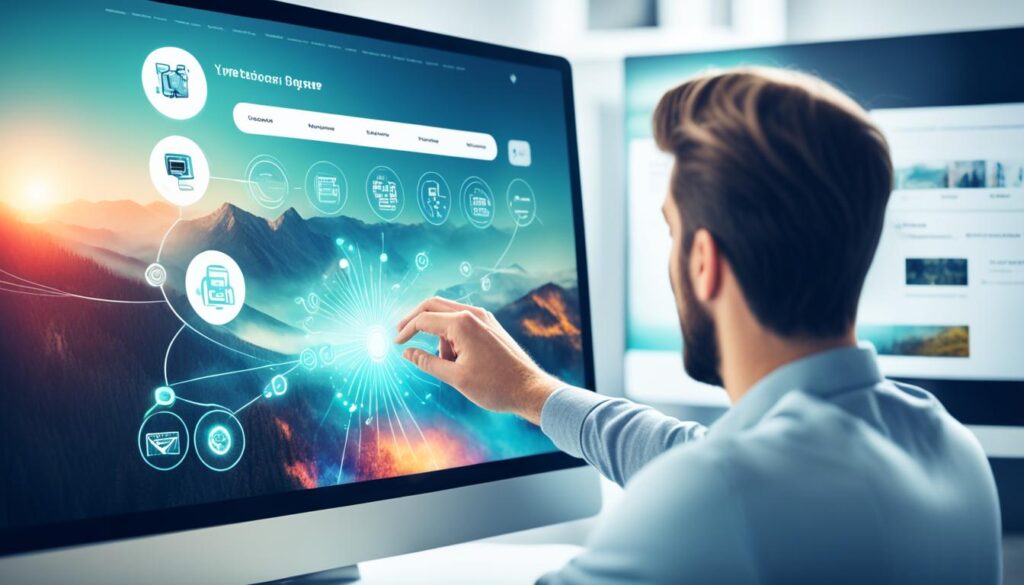
Conclusion
In summary, this article has explored nine futuristic designs that can make your website stand out in 3021. By implementing these designs, you can increase your online visibility, attract more organic traffic, and enhance the user experience.
Setting a new standard for unparalleled online experiences is crucial in the ever-evolving digital landscape. By embracing design and innovation, you can stay ahead of the competition and create websites that truly captivate and engage visitors.
As we look towards the future of website design, it is clear that the integration of virtual realities, intuitive AI interfaces, eco-conscious design, and the merging of art and functionality will play key roles. Moreover, adopting advanced SEO strategies, hyper-personalization techniques, and staying updated on the latest industry trends will be essential to ensure your website remains relevant and successful.
FAQ
How can I make my website stand out from the competition?
How can I improve the user experience on my website?
How can I develop an eco-conscious website?
What design elements should I focus on to create an aesthetically pleasing and functional website?
How can I improve my search engine rankings?
How can I deliver personalized experiences to website visitors?
Source Links
- https://www.creativestream.co.uk/
- https://urbanistarchitecture.co.uk/5-ways-design-buildings-specifically-long-term-maintenance

